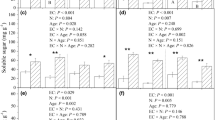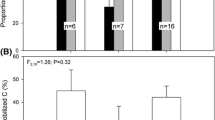Abstract
It is unclear whether the frequently observed increase in non-structural carbohydrates (NSC) in plants exposed to low temperatures or drought reflects a higher sensitivity of growth than photosynthesis in such conditions (i.e. sink limitation), or a prioritization of carbon (C) allocation to storage. Alpine areas in Mediterranean-type climate regions are characterized by precipitation increases and temperature decreases with elevation. Thus, alpine plants with wide elevational ranges in Mediterranean regions may be good models to examine these alternative hypotheses. We evaluated storage and growth during experimental darkness and re-illumination in individuals of the alpine plant Phacelia secunda from three elevations in the Andes of central Chile. We hypothesized that storage is prioritized regarding growth in plants of both low- and high elevations where drought and cold stress are greatest, respectively. We expected that decreases in NSC concentrations during darkness should be minimal and, more importantly, increases in NSC after re-illumination should be higher than increases in biomass. We found that darkness caused a significant decrease in NSC concentrations of both low- and high-elevation plants, but the magnitude of the decrease was lower in the latter. Re-illumination caused higher increase in NSC concentration than in biomass in both low- and high-elevation plants (1.5- and 1.9-fold, respectively). Our study shows that C allocation in Phacelia secunda reflects ecotypic differences among elevation provenances and suggests that low temperature, but not drought, favours C allocation to storage over growth after severe C limitation.





Similar content being viewed by others
References
Arroyo MK, Armesto JJ, Villagran C (1981) Plant phenological patterns in the high Andean cordillera of central Chile. J Ecol 69:205–223. https://doi.org/10.2307/2259826
Ávila-Valdés A, Piper FI, Zúñiga-Feest A (2019) Cluster root formation and function vary in two species with contrasting geographic ranges. Plant Soil 440:25–38
Bachofen C, Moser B, Hoch G, Ghazoul J, Wohlgemuth T (2018) No carbon “bet hedging” in pine seedlings under prolonged summer drought and elevated CO2. J Ecol 106:31–46. https://doi.org/10.1111/1365-2745.12822
Bates D, Maechler M, Bolker B, Walker S (2014) lme4: Linear mixed-effects models using Eigen and S4. R Package Version 1:1–23
Boyer JS (1970) Leaf enlargement and metabolic rates in corn, soybean, and sunflower at various laf water potentials. Plant Physiol 46:233–235. https://doi.org/10.1104/pp.46.2.233
Canham CD, Kobe RK, Latty EF, Chazdon RL (1999) Interspecific and intraspecific variation in tree seedling survival: effects of allocation to roots versus carbohydrate reserves. Oecologia 121:1–11
Cavieres LA (2000) Variación morfológica de Phacelia secunda J.F. Gmel. (Hydrophyllaceae) a lo largo de un gradiente a ltitudinal en Chile central. Gayana Bot 57:89–96. https://doi.org/10.4067/S0717-66432000000100007
Cavieres LA, Peñaloza A, Papic C, Tambutti M (1998) Efecto nodriza de Laretia acaulis en plantas de la zona andina de Chile central. Rev Chil Hist Nat 71:337–347
Cavieres LA, Penaloza A, Arroyo MK (2000) Altitudinal vegetation belts in the high-Andes of central Chile (33 S). Rev Chil Hist Nat 7:331–344. https://doi.org/10.4067/S0716-078X2000000200008
Cavieres LA, Badano EI, Sierra-Almeida A, Gómez-González S, Molina-Montenegro MA (2006) Positive interactions between alpine plant species and the nurse cushion plant Laretia acaulis do not increase with elevation in the Andes of central Chile. New Phytol 169:59–69. https://doi.org/10.1111/j.1469-8137.2005.01573.x
Chapin FS III, Schulze ED, Mooney HA (1990) The ecology and economics of storage in plants. Annu Rev Ecol Syst 21:423–447
Chatterton N, Harrison P, Bennett J, Asay K (1989) Carbohydrate partitioning in 185 accessions of Gramineae grown under warm and cool temperatures. J Plant Physiol 134:169–179. https://doi.org/10.1016/S0176-1617(89)80051-3
Dietze MC, Sala A, Carbone MS, Czimczik CI, Mantooth JA, Richardson AD, Vargas R (2014) Nonstructural carbon in woody plants. Annu Rev Plant Biol 65:667–687. https://doi.org/10.1146/annurev-arplant-050213-040054
Fajardo A, Piper FI (2014) An experimental approach to explain the southern Andes elevational treeline. Am J Bot 101:788–795. https://doi.org/10.3732/ajb.1400166
Fajardo A, Piper FI, Cavieres LA (2011) Distinguishing local from global climate influences in the variation of carbon status with altitude in a tree line species. Global Ecol Biogeogr 20:307–318. https://doi.org/10.1111/j.1466-8238.2010.00598.x
Fatichi S, Leuzinger S, Körner C (2014) Moving beyond photosynthesis: from carbon source to sink-driven vegetation modeling. New Phytol 201:1086–1095. https://doi.org/10.1111/nph.12614
García-Lino MC, Cavieres LA, Zotz G, Bader MY (2017) Carbohydrate reserves in the facilitator cushion plant Laretia acaulis suggest carbon limitation at high elevation and no negative effects of beneficiary plants. Oecologia 183:997–1006. https://doi.org/10.1007/s00442-017-3840-5
Guevara-Figueroa T, López-Hernández L, Lopez M, Hurtado MD, Vázquez-Barrios M, Guevara-Olvera L, González RG, Rivera-Pastrana D, Torres-Robles H, Mercado-Silva E (2015) Conditioning garlic “seed” cloves at low temperature modifies plant growth, sugar, fructan content, and sucrose sucrose fructosyl transferase (1-SST) expression. Sci Hortic 189:150–158. https://doi.org/10.1016/j.scienta.2015.03.030
Handa S, Bressan RA, Handa AK, Carpita NC, Hasegawa PM (1983) Solutes contributing to osmotic adjustment in cultured plant cells adapted to water stress. Plant Physiol 73:834–843. https://doi.org/10.1104/pp.73.3.834
Hendry G (1987) The ecological significance of fructan in a contemporary flora. New Phytol 106:201–216. https://doi.org/10.1111/j.1469-8137.1987.tb04690.x
Hendry GA (1993) Evolutionary origins and natural functions of fructans–a climatological, biogeographic and mechanistic appraisal. New Phytol 123:3–14. https://doi.org/10.1111/j.1469-8137.1993.tb04525.x
Hernández-Fuentes C, Bravo LA, Cavieres LA (2015) Photosynthetic responses and photoprotection strategies of Phacelia secunda plants exposed to experimental warming at different elevations in the central Chilean Andes. Alpine Bot 125:87–99
Hincha DK, Hagemann M (2004) Stabilization of model membranes during drying by compatible solutes involved in the stress tolerance of plants and microorganisms. Biochem J 383:277–283. https://doi.org/10.1042/BJ20040746
Hoch G (2015) Carbon reserves as indicators for carbon limitation in trees. In: Lüttge U, Beyschlag W (eds) Progress in Botany Progress in Botany (Genetics — Physiology — Systematics — Ecology), vol 76. Springer, Cham, Berlin, pp 321–346
Hoch G, Körner C (2003) The carbon charging of pines at the climatic treeline: a global comparison. Oecologia 135:10–21. https://doi.org/10.1007/s00442-002-1154-7
Hoch G, Körner C (2009) Growth and carbon relations of tree line forming conifers at constant vs. variable low temperatures. J Ecol 97:57–66
Hoch G, Popp M, Körner C (2002) Altitudinal increase of mobile carbon pools in Pinus cembra suggests sink limitation of growth at the Swiss treeline. Oikos 98:361–374. https://doi.org/10.1034/j.1600-0706.2002.980301.x
Kami C, Lorrain S, Hornitschek P, Fankhauser C (2010) Light-regulated plant growth and development. Current topics in developmental biology, vol 91. Elsevier, pp 29–66
Kitajima K (1994) Relative importance of photosynthetic traits and allocation patterns as correlates of seedling shade tolerance of 13 tropical trees. Oecologia 98:419–428
Körner C (2003a) Alpine plant life: functional plant ecology of high mountain ecosystems, 2nd edn. Springer Science and Business Media, Berlin
Körner C (2003b) Carbon limitation in trees. J Ecol 91:4–17
Körner C (2015) Paradigm shift in plant growth control. Curr Opin Plant Biol 25:107–114. https://doi.org/10.1016/j.pbi.2015.05.003
Körner C, Riedl S, Keplinger T, Richter A, Wiesenbauer J, Schweingruber F, Hiltbrunner EJAB (2019) Life at 0° C: the biology of the alpine snowbed plant Soldanella pusilla. Acta Chem Scand 129:63–80
Le Roy K, Lammens W, Verhaest M, De Coninck B, Rabijns A, Van Laere A, Van den Ende W (2007) Unraveling the difference between invertases and fructan exohydrolases: a single amino acid (Asp-239) substitution transforms Arabidopsis cell wall invertase1 into a fructan 1-exohydrolase. Plant Physiol 145:616–625. https://doi.org/10.1104/pp.107.105049
Lenth RV (2016) Least-squares means: the R package lsmeans. J Stat Softw 69:1–33. https://doi.org/10.18637/jss.v069.i01
Martínez-Vilalta J, Sala A, Asensio D, Galiano L, Hoch G, Palacio S, Piper FI, Lloret F (2016) Dynamics of non-structural carbohydrates in terrestrial plants: a global synthesis. Ecol Monogr 86:495–516. https://doi.org/10.1002/ecm.1231
McCleary BV, Murphy A, Mugford DC (2000) Measurement of total fructan in foods by enzymatic/spectrophotometric method: collaborative study. J AOAC Int 83:356–364
Monson RK, Rosenstiel TN, Forbis TA, Lipson DA, Jaeger CH III (2006) Nitrogen and carbon storage in alpine plants. Integr Comp Biol 46:35–48. https://doi.org/10.1093/icb/icj006
Mooney H, Billings W (1960) The annual carbohydrate cycle of alpine plants as related to growth. Am J Bot 47:594–598. https://doi.org/10.1002/j.1537-2197.1960.tb14911.x
Muller B, Pantin F, Génard M, Turc O, Freixes S, Piques M, Gibon Y (2011) Water deficits uncouple growth from photosynthesis, increase C content, and modify the relationships between C and growth in sink organs. J Exp Bot 62:1715–1729. https://doi.org/10.1093/jxb/erq438
Myers JA, Kitajima K (2007) Carbohydrate storage enhances seedling shade and stress tolerance in a neotropical forest. J Ecol 95:383–395. https://doi.org/10.1111/j.1365-2745.2006.01207.x
Nogués S, Aljazairi S, Arias C, Sánchez E, Aranjuelo I (2014) Two distinct plant respiratory physiotypes might exist which correspond to fast-growing and slow-growing species. J Plant Physiol 171:1157–1163
O’Brien MJ, Leuzinger S, Philipson CD, Tay J, Hector A (2014) Drought survival of tropical tree seedlings enhanced by non-structural carbohydrate levels. Nature Climate Change 4:710. https://doi.org/10.1038/NCLIMATE2281
Peñaloza A, Cavieres LA, Arroyo MT, Torres C (2001) Efecto nodriza intra-específico de Kageneckia angustifolia D. Don (Rosaceae) sobre la germinación de semillas y sobrevivencia de plántulas en el bosque esclerófilo montano de Chile central. Rev Chil Hist Nat 74:539–548
Piper FI, Fajardo A (2016) Carbon dynamics of Acer pseudoplatanus seedlings under drought and complete darkness. Tree Physiol 36:1400–1408. https://doi.org/10.1093/treephys/tpw063
Piper FI, Gundale MJ, Fajardo A (2015) Extreme defoliation reduces tree growth but not C and N storage in a winter-deciduous species. Ann Bot 115:1093–1103. https://doi.org/10.1093/aob/mcv038
Piper FI, Viñegla B, Linares JC, Camarero JJ, Cavieres LA, Fajardo A (2016) Mediterranean and temperate treelines are controlled by different environmental drivers. J Ecol 104:691–702. https://doi.org/10.1111/1365-2745.12555
Pollock CJ (1986) Tansley review no. 5 Fructans and the metabolism of sucrose in vascular plants. New Phytol 104:1–24. https://doi.org/10.1111/j.1469-8137.1986.tb00629.x
Sala A, Hoch G (2009) Height-related growth declines in ponderosa pine are not due to carbon limitation. Plant Cell Environ 32:22–30. https://doi.org/10.1111/j.1365-3040.2008.01896.x
Sala A, Woodruff DR, Meinzer FC (2012) Carbon dynamics in trees: feast or famine? Tree Physiol 32:764–775. https://doi.org/10.1093/treephys/tpr143
Santibañez F, Uribe JM (1990) Atlas agroclimático de Chile: Regiones V y Metropolitana.
Sierra-Almeida A, Cavieres LA (2010) Summer freezing resistance decreased in high-elevation plants exposed to experimental warming in the central Chilean Andes. Oecologia 163:267–276. https://doi.org/10.1007/s00442-010-1592-6
Smith AM, Stitt M (2007) Coordination of carbon supply and plant growth. Plant Cell Environ 30:1126–1149. https://doi.org/10.1111/j.1365-3040.2007.01708.x
Smith WK, Germino MJ, Hancock TE, Johnson DM (2003) Another perspective on altitudinal limits of alpine timberlines. Tree Physiol 23:1101–1112. https://doi.org/10.1093/treephys/23.16.1101
Tolsma A, Read S, Tolhurst K (2008) Roots of Australian alpine plant species contain high levels of stored carbohydrates independent of post-fire regeneration strategy. Aust J Bot 55:771–779. https://doi.org/10.1071/BT06216
Valluru R, Van den Ende W (2008) Plant fructans in stress environments: emerging concepts and future prospects. J Exp Bot 59:2905–2916. https://doi.org/10.1093/jxb/ern164
Weber R, Schwendener A, Schmid S, Lambert S, Wiley E, Landhäusser SM, Hartmann H, Hoch G (2018) Living on next to nothing: tree seedlings can survive weeks with very low carbohydrate concentrations. New Phytol 218:107–118. https://doi.org/10.1111/nph.14987
Wiley E, Helliker B (2012) A re-evaluation of carbon storage in trees lends greater support for carbon limitation to growth. New Phytol 195:285–289. https://doi.org/10.1111/j.1469-8137.2012.04180.x
Wyka T (1999) Carbohydrate storage and use in an alpine population of the perennial herb, Oxytropis sericea. Oecologia 120:198–208. https://doi.org/10.1007/s004420050849
Zhang T, Cao Y, Chen Y, Liu G (2015) Non-structural carbohydrate dynamics in Robinia pseudoacacia saplings under three levels of continuous drought stress. Trees 29:1837–1849. https://doi.org/10.1007/s00468-015-1265-5
Acknowledgements
We thank to Andrea Reyes for assistance in NSC analyses, Caroline Dallstream for grammar corrections and Centro de Investigación en Ecosistemas de la Patagonia (CIEP) and Laboratorio de Cultivo de Tejidos Vegetales (Universidad de Concepción) for providing laboratory facilities. This study was funded by Project Fondecyt 1130592 to L.A.C, Fondecyt 1160330 and 1190927 to F.I.P., and CONICYT doctoral scholarship to CRB. Additional funding from CONICYT PIA CCTE AFB170008 is also acknowledged.
Author information
Authors and Affiliations
Contributions
CRB designed the experiment, performed the experiment and analysed carbohydrates and fructans, CRB, LAC and FIP analysed the data and wrote the manuscript.
Corresponding author
Additional information
Communicated by Hermann Heilmeier.
Supplementary Information
Below is the link to the electronic supplementary material.
Rights and permissions
About this article
Cite this article
Reyes-Bahamonde, C., Piper, F.I. & Cavieres, L.A. Carbon allocation to growth and storage depends on elevation provenance in an herbaceous alpine plant of Mediterranean climate. Oecologia 195, 299–312 (2021). https://doi.org/10.1007/s00442-020-04839-x
Received:
Accepted:
Published:
Issue Date:
DOI: https://doi.org/10.1007/s00442-020-04839-x




